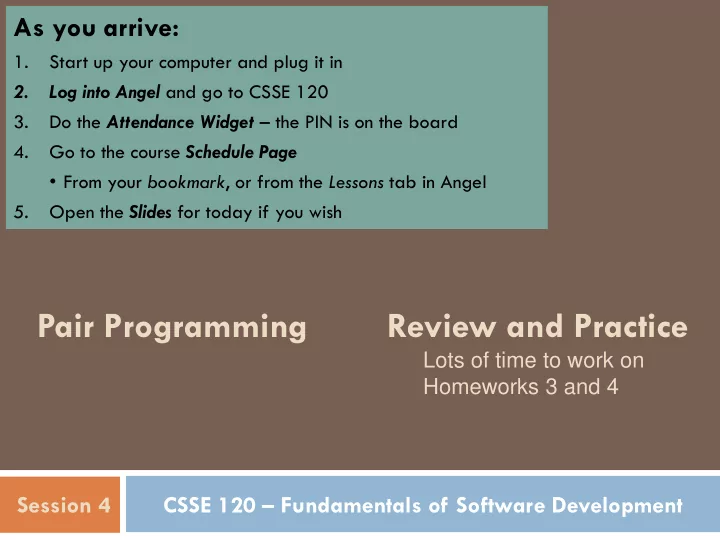

As you arrive: 1. Start up your computer and plug it in 2. Log into Angel and go to CSSE 120 3. Do the Attendance Widget – the PIN is on the board 4. Go to the course Schedule Page • From your bookmark , or from the Lessons tab in Angel 5. Open the Slides for today if you wish Pair Programming Review and Practice Lots of time to work on Homeworks 3 and 4 Session 4 CSSE 120 – Fundamentals of Software Development
Outline Review Pair Programming Starting a program in main . How to Most of today is define a function, call a function. Practice, Practice, Organizing a program into functions Practice on: The input-compute-output pattern Homework 3 Functions with parameters that return factorial values barChart Parameters and variables defined in functions are local to that function Conversion Capture the returned value in a variable, or Homework 4 use it directly bullsEye Definite loops , using a range statement countIntegers The Accumulator Loop pattern
Check out project for today 3 Go to SVN Repository view, at bottom of the workbench If it is not there, Window Show View Other SVN SVN Repositories Browse SVN Repository view for 04-ReviewAndPractice project Right-click it, and choose Checkout Accept options as presented Expand the 04-ReviewAndPractice project that appears in Package Explorer (on the left-hand-side) Browse the modules. We will start with 1-mainStructure.py (next slide)
Review – in Eclipse 04-ReviewAndPractice 1-mainStructure: Starting a program in main . How to define a function, call a function. 2-inputComputeOutput: How to organize a program into functions. How to input and convert the input to a float ('int' would convert to an int). How to print (i.e., produce output). How to use a FOR loop. This FOR loop is a definite loop using RANGE. It can be thought of as an example of the Accumulator Loop pattern. How to use local variables for the constant (3.9) and howManyToPrint (10), along with the input variable (x) and the loop variable (k).
More review – in Eclipse 04-ReviewAndPractice 3-functionsWithParameters: Functions with parameters that return values How to define a function with parameters How to call that function, supplying actual arguments whose values the parameters are assigned to Parameters and variables defined in functions are local to that function Capture the returned value in a variable, or use it directly It is all a question of SPECIFICATION communicating with the user of your code. Appending to a list 4-accumulatorLoopPattern: What the Accumulator Loop pattern is, example
Pair Programming 6 Working in pairs on a single computer One person, the driver , uses the keyboard The other person, the navigator , watches, thinks, and takes notes For hard (or new) problems, this technique Reduces number of errors Saves time in the long run Works best when partners have similar skill level If not, then student with most experience should navigate, while the other student drives.
Food tasting 7 Suppose you are at food tasting show and are tasting 5 different dishes Sampling the dishes in different orders may affect how good they taste If you want to try out every possible ordering, how many different orders would there be? That number is the factorial of 5 n! = n (n – 1) (n – 2) … (1) What type of problem is this?
Accumulating results: factorial 8 Work with a partner (pick a driver and navigator) Follow the advice in www.rose- hulman.edu/class/csse/csse120/201110/Resources/pair Programming.html for how to work together, whose machine you should use, how to turn in your collaborative work, and how you will both end up with a graded version of that work. Do the TODO’s in factorial.py in 03-assignmentsAndLoops Those TODO’s will direct you to write and test a function that computes n!, for any given n.
Graphics Exercise with loops 9 Trade roles with partner — new driver, new navigator Do the TODO’s in barChart.py in 03-assignmentsAndLoops They will direct you to draw a figure like this where the lengths of the lines increase by a constant amount The graphicsExample module that we supplied and your previous graphics program may be useful. You may want to use variables to hold current x-coordinate and current line length, and change the values of those variables each time through the loop
Rest of today 10 Do your pair programming from Homework 3 factorial barChart Do your individual work from Homework 3 conversion And Homework 4 bullsEye sumAndCount Don’t forget the reading quizzes in both homework Both homework are due Monday
Recommend
More recommend